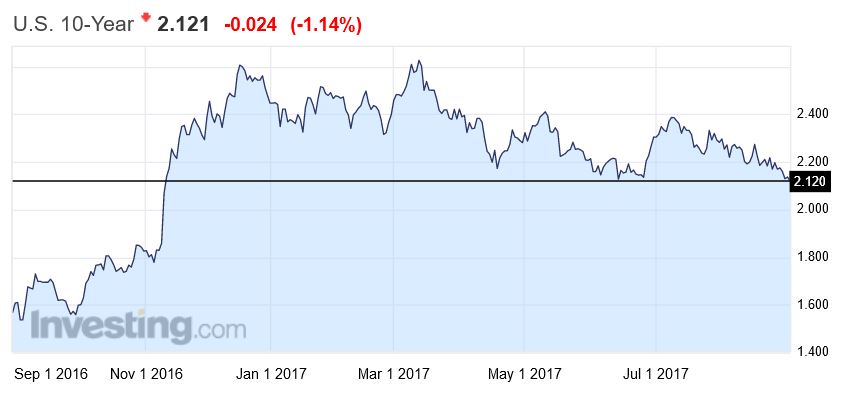The latest data from the US which shows low inflation and wage growth has pulled the implied forward interest rates down suggesting the Fed will hold rates lower for longer. This is reflected in falling yields on the T10.
Nearly half of the “Trump Effect” repricing has been undone.
 This is also flowing into lower rates in the international capital markets, which is translating to lower costs of funds for the Australian banks (one reason why Westpac has cut their fixed rates).
This is also flowing into lower rates in the international capital markets, which is translating to lower costs of funds for the Australian banks (one reason why Westpac has cut their fixed rates).
As a result, in our default model, we have reduced the likelihood of an interest rate rise for mortgage holders in Australia over the next few months. This will translate to a projected fall in defaults, despite rising mortgage stress. We will publish the August data on Monday. Households are likely to be able to muddle through and the RBA will hope business investment, which was stronger this time, works through.
Meantime, here is interesting commentary from Moody’s on the US, who highlight that the latest drop by personal savings in the US brings attention to the financial stress now facing many households there.
The recent slowdown by the underlying rate of consumer price inflation significantly lowered the risk of a disruptive climb by interest rates. In response, the VIX index sank from the 16.0 points of August 10, 2017 to a recent 10.7 points, while a composite high-yield bond spread narrowed from August 11’s 410 bp to August 30’s 399 bp.
However, the narrowing by the high-yield bond spread has been limited by a climb by the average high yield EDF (expected default frequency) metric from the July 2017 average of 3.9% to the 4.4% average of the five-days-ended August 30. Moreover, the US high-yield credit rating revisions of the third-quarter todate show downgrades topping upgrades even after excluding rating changes that were not primarily driven by fundamentals.
As recently as early July 2017, the Blue Chip consensus had anticipated a 2.5% average for Q3-2017’s 10-year Treasury yield. Much to the contrary, the 10-year Treasury yield has averaged 2.26% thus far in the third quarter, including a recent 2.13%. Not even a widely anticipated September 2017 start to the Fed’s reduced reinvestment of maturing bonds has been capable of lifting Treasury bond yields demonstrably.
In addition to July’s 1.4% annual rate of core PCE price index inflation, benchmark bond yields have been reined in by the market’s much reduced expectation of another Fed rate hike for 2017. As of mid-day on August 31, the futures market implicitly assigned only a 36.4% likelihood to fed funds’ midpoint finishing 2017 at something greater than its current 1.125% according to the CME Group’s FedWatch tool.
By itself, core PCE price index inflation’s performance of the last 20 years suggests that the FOMC may have considerable difficulty as far as sustaining PCE price index inflation at 2% or higher. For the 20-years-ended June 2017, core PCE price index inflation averaged only 1.7% annually. The annual rate of core PCE price index inflation was at least 2% in only 58, or 24.2%, of the last 240 months (20 years).
For those months showing an annual rate of core PCE price index inflation of at least 2%, the average annual rate of core inflation was only 2.2%, wherein the fastest annual rate of core inflation was the 2.5% of August 2006.
Drop by personal savings curbs core inflation
The slower growth of wage and salary income has helped to contain price inflation. After decelerating from 2014’s 5.6% and 2015’s 5.5% to 2016’s 3.0%, the annual increase of private-sector wages and salaries approximated a still sluggish 3.1% during January-July 2017. In response to the pronounced slowdown by wages and salaries, personal savings have shrunk by -29% annually thus far in 2017 following yearlong 2016’s -18% plunge.
The drop by the ratio of personal savings to disposable personal income from its 6.1% average of the five years ended 2015 to the 3.8% of 2017 to date implies Americans lack the financial wherewithal to either support or absorb significantly higher prices for long.
High rates of personal savings make it easier for consumers to absorb higher prices. When core PCE price index inflation averaged 6.4% during 1970-1981, the personal savings rate averaged 11.7%. By contrast, the averages for January-July 2017 showed a much lower 3.8% personal savings rate and a much slower 1.6% annual rate of core PCE price index inflation.
In addition, the latest drop by personal savings brings attention to the financial stress now facing many US households. Today’s more unequal distribution of income implies that a relatively greater number of today’s households save little, if any, of their after-tax income. When confronted with higher prices, these “paycheck-to-paycheck” consumers will be compelled to eventually curtail real spending at the expense of business pricing power.

One thought on “Low US Inflation Signals Interest Rates Will Remain Lower For Longer”